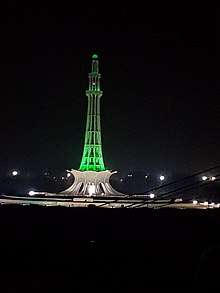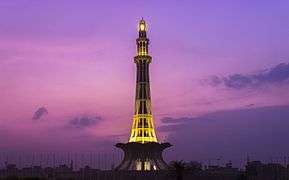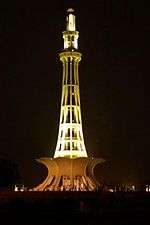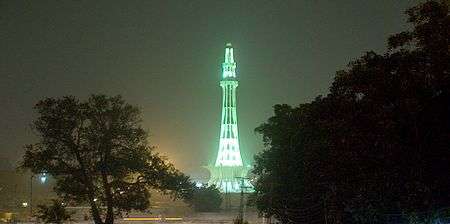Minar-e-Pakistan
| Minar-e-Pakistan مینارِ پاکستان | |
|---|---|
 | |
|
Location within Lahore  Minar-e-Pakistan (Pakistan) | |
| General information | |
| Status | National Tower of Pakistan |
| Type | Public monument |
| Location |
Lahore, Punjab |
| Coordinates | 31°35′33″N 74°18′34″E / 31.5925°N 74.3095°ECoordinates: 31°35′33″N 74°18′34″E / 31.5925°N 74.3095°E |
| Construction started | 23 March 1960 |
| Completed | 21 October 1968 |
| Height | |
| Roof | 62 metres (203 ft) |
| Design and construction | |
| Architect | Nasreddin Murat-Khan |
| Structural engineer | A Rehman Niazi |
| Main contractor | Mian Abdul Khaliq Company |
Minar-e-Pakistan (Urdu: مینارِ پاکستان) is a national monument located in Lahore, Pakistan.[1] The tower was built between 1960 and 1968 on the site where the All-India Muslim League passed the Lahore Resolution on 23 March 1940 - the first official call for a separate and independent homeland for the Muslims of British India, as espoused by the two-nation theory. The resolution eventually helped lead to the emergence of an independent Pakistani state in 1947.
Design
The tower reflects a blend of Mughal/Islamic and modern architecture.
The tower was designed and supervised by, an architect and engineer hailing from Punjab.[2] The foundation stone was laid on 23 March 1960. Construction took eight years, and was completed on 21 October 1968 at an estimated cost of Rs 7,058,000. The money was collected by imposing an additional tax on cinema and horse racing tickets at the demand of Akhtar Hussain, governor of West Pakistan. Today, the minaret provides a panoramic view to visitors who can't climb up the stairs or access the top, by means of an elevator. The parks around the monument include marble fountains and an artificial lake.
Structure
The base is about 8 metres above the ground. The tower rises about 62 metres on the base, the total height of the minar is about 70 metres above the ground. The unfolding petals of the flower-like base are 9 metres high. The diameter of the tower is about 9.75 meters. The rostrum is built of patterned tiles, and faces Badshahi Mosque. The base comprises four platforms. To symbolise the humble beginning of the freedom struggle, first platform is built with uncut stones from Taxila, second platform is made of hammer-dressed stones, whereas third platform is of chiselled stones. Polished white marble at the fourth and final platform depicts the success of the Pakistan Movement.[3] Mr. Mukhtar Masood, a prolific writer and the then–deputy commissioner of Lahore, was one of the members of the Building Committee. Mian Abdul Khaliq and Company went on to build many other landmarks of Pakistan including the Gaddafi Stadium (also designed by Murat-Khan)[4] and BRB Canal.
Inscriptions
At the base, there are floral inscriptions on ten converging white marble Commemorative plaques. The inscriptions include the text of Lahore Resolution in Urdu, Bengali and English, and Delhi Resolution's text, which was passed on 9 April 1946. On different plaques, Quranic verses and 99 attributes of Allah are inscribed in Arabic calligraphy, whereas National Anthem of Pakistan in Urdu and Bengali, excerpts from the speeches of Muhammad Ali Jinnah, in Urdu, Bengali and English, along with few couplets of Allama Iqbal include the other important inscriptions.[3]
Symbolic importance
Minar-e-Pakistan has served as the location for a number of rallies.[5]
Construction
Tower construction was started in 1960 and it took 8 years to complete in 1968.The estimated budget to complete the great construction near Rs.70 Lakh (7 million). It is the combination of Islamic as well as national culture. The tower base is shaped like a flower. The monument is covered with parks and flowers. Its location is used for political and religious events. It is also known as "Tower of Pakistan".

Gallery
 Minar-e-Pakistan Lahore
Minar-e-Pakistan Lahore- Minar-e-Pakistan
 View at Night
View at Night
 Minar-e-Pakistan at Night
Minar-e-Pakistan at Night Minar-e-Pakistan Ground Level
Minar-e-Pakistan Ground Level View of Minar-e-Pakistan at Night
View of Minar-e-Pakistan at Night Minar-e-Pakistan richly framed by an aisle arch
Minar-e-Pakistan richly framed by an aisle arch Minar-e-Pakistan night view
Minar-e-Pakistan night view
See also
References
- ↑ Google maps. "Address of Minar-e-Pakistan". Google maps. Retrieved 23 September 2013.
- ↑ Meral Murat Khan. "Remembrance: The man behind the masterpiece". Dawn. Retrieved 5 December 2012.
- 1 2 Amna Jamal (2002) The Pakistan Day memorial. Dawn. 23 March. Retrieved 12 February 2008
- ↑ Meral Murat-Khan
- ↑ "PTI to stage rally at Minar-e-Pakistan today". The News International. 23 March 2013.
External links
| Wikimedia Commons has media related to Minar-e-Pakistan. |